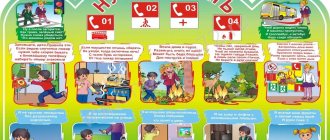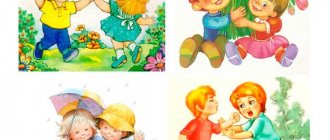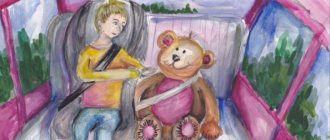Summer is the shortest and most awaited time of the year for children and their parents. While you have the opportunity, you want to do everything: take a walk, swim, ride a bike, and do other exciting things that you never have time for in winter. And so that the long holidays are not overshadowed by injuries and illnesses, it is enough to follow the summer safety rules for children: both adults and, of course, the children themselves.
Even if your child is a model of responsibility and caution, still remind him often of the basics of safe behavior in the summer. As the experience of traumatologists and pediatricians shows, even adults do not always know how to behave in an emergency situation, and children even more so.
Preparing for outdoor recreation
If you plan to spend time in nature, you should prepare for this pastime in advance.
- It is recommended to choose clothing that will tightly cover your neck, arms and legs from dangerous insects and animals such as ticks, ants and snakes.
- Care should be taken to purchase a headdress made of thick fabric.
- It is better not to wear a scarf, as it can get caught on branches of trees or bushes.
- The importance of communication devices should not be underestimated. It is advisable for a person going to nature to take a mobile phone with him. The vacationer should also have matches, a knife and a watch.
- You can use an insect repellent, especially if the vacationer plans to stay in an open area or in a tent for a long time.
- If a vacationer plans to have a picnic, then he needs to take care of purchasing garbage containers in advance. All waste left over after eating must be placed in bags or special containers and thrown away in designated areas.
Basic rules of behavior in nature
- It is not recommended to stay in nature until dark.
- You should not leave the paths and trails.
- If a person realizes that he is lost, he should listen to the surrounding sounds. The noise of cars or the barking of a dog can help you find directions to the nearest town.
- You should not rest near anthills, wasp nests and other dangerous objects. Before setting up your tent, you need to carefully inspect the surrounding area.
- You should not pick unfamiliar berries and mushrooms, as they can be poisonous.
- It is not recommended to drink water from reservoirs, as there is a high probability that it is unsuitable for drinking.
- It is important to avoid using devices that play loud music as it may disturb animals. Sharp unnatural sounds frighten animals, making them irritable and aggressive.
- Avoid using eau de parfum or perfume as strong odors may attract insects.
What should a child know before going outdoors?
Children's favorite way to get to know the world around them is to put everything they can get their hands on into their mouths. Therefore, wildlife objects can cause danger. It is worth explaining to the little ones that they cannot try the berries they encounter without showing them to adults. The same applies to other gifts of nature.
Older children should be taught how to move around the forest correctly: you shouldn’t rush around headlong, because if you trip over a random stone or root you can be seriously injured.
The main dos and don'ts
| Can be done with adults | Can't do |
| Approach bodies of water | Run away from adults |
| Play in the water | Go far into the forest |
| Approach an open fire | Throw garbage |
| Collect bouquets | Aimlessly pick flowers and grass |
| Collect berries and nuts | Try raw mushrooms, unfamiliar fruits |
| Look at anthills | Pick up fauna representatives |
It is useful to explain to children that all living beings have the right to live and grow. Therefore, you cannot kill insects, spoil berry bushes and mushrooms, even poisonous ones. Every plant and animal is an important part of the ecosystem; deprivation of one representative of flora or fauna can negatively affect nature.
When in the forest with a child, take care of his safety:
- the baby should not be in the sun for too long;
- clothes should be as bright as possible so that the child can be clearly seen.
Pack and take a small first aid kit with you, because a young city dweller who is not accustomed to insects and plants may get hurt or react too sensitively to pollen.
A portable first aid kit should contain:
- hydrogen peroxide;
- brilliant green or iodine;
- Activated carbon;
- burn remedy;
- antihistamine;
- repellent and remedy for mosquito and bumblebee bites;
- antibacterial wet wipes.
After finishing an amazing forest adventure, remind your child that all garbage must be collected and taken with them, and the fire must be extinguished to prevent a forest fire.
It is necessary to follow simple rules of behavior in nature; for children, following them will be a guarantor of safety, will help them learn a caring attitude towards living beings, vision and understanding of beauty, and will instill in children a love for their native land.
Rules in nature - reminder
| Season | It is forbidden |
| Spring | · pick primroses; · destroy birds' nests; · burn out last year's grass. |
| Summer | · tear off webs and kill spiders; · try to catch butterflies, bees, dragonflies; · pick berries and mushrooms that you were not familiar with before. |
| Autumn | · set fire to dry leaves and grass; · pick mushrooms. |
| Winter | · touch and break fragile branches; · scare forest inhabitants. |
| In any season | · damage the bark of trees; · leave fires unextinguished; · make noise; · break shoots of bushes and tree branches; · catch animals, birds, take them home; · leave trash. |
Children's safety in the summer - general rules
Brief instructions on basic summer safety rules:
Bathing
You can only swim in places equipped for swimming; you cannot swim far or play unsafe games.
Sun
You should always wear a hat during the day - not only on sunny days, but also when there are clouds in the sky. Avoid being in direct sunlight for too long.
Food and water
It is necessary to carefully check the expiration date of products, do not take perishable food into nature, try to drink more clean, unsweetened water and always wash your hands before eating.
Insects
If there is a potentially dangerous insect (bee, wasp) nearby, you need to avoid sudden movements.
Communication
If a child is walking without his parents, he can only communicate with people he knows well. You can't call for help as a joke.
Are you worried about your child when he walks without your accompaniment? Rest assured that he is safe and in no danger. Download the “Where are my children” application from the AppStore and GooglePlay stores.
Movement
It is imperative to look at your feet. And not only so as not to trample mushrooms and flowers, but also so as not to fall off the slope, not to step on a snake, etc. If there are paths in the area you need to walk through, then it is best to follow them. If a large group of vacationers has gathered in a clearing, it is better to disperse so as not to disturb the vegetation cover.
To avoid damaging lichen and moss, it is better to move on them when they are wet. You cannot go straight down the slopes. Ideally, you need to move at low speed and in zigzags.
Camp setup
There are certain rules of behavior in nature for pitching tents and bivouacs. They need to be installed in a safe and open place, but not in clearings with moss. If you plan to plant them near water, it is better to do this outside the water protection zone. Dead wood is used for tent poles. Or you can take the stands with you, as well as pegs for fastening to the ground.
For toilets and food waste, you need to dig a hole, but no closer than 50 m from the reservoir. When leaving, you should bury it, or cover it with removed turf, and all debris should be burned. What will not burn, take it with you (products made of plastic, iron and glass).
Rules of conduct on the river
Swimming is a favorite activity for children, but cool river water can be dangerous. It is important to know the rules, which in Russia have not changed much since the 19th century. Rules of behavior for children on the water:
- You should not dive in unfamiliar places.
- Do not play dangerous games with capture.
- In winter and spring, do not go on the ice.
- If you don’t know how to swim, use armbands or an inflatable ring.
- You cannot drink water from the pond.
- Don't swim too far. Unless you are a strong swimmer, avoid long distance throws. This could end badly.
- Do not enter the water while intoxicated. Especially in the heat. Low water temperature and high air temperature will cause temperature shock. This is fraught with consequences.
- Pay attention to special signs and pointers describing the rules of behavior in nature; the pictures depicted on them will help you find your way.
- If there is a sign indicating that swimming is prohibited, do not take risks.
- Having discovered a previously unfamiliar body of water, try to analyze whether it is suitable for swimming. Muddy water, strange snags, lack of flow and stagnant water are bad signs. Good – no thickets nearby, running water at an acceptable temperature.
What are the rules of behavior in nature for children near water:
- Don't let children go too deep;
- Check the water temperature; children should not be in water with a temperature below 26 degrees;
- Acceptable residence time is up to 10 minutes. In warmer water – from 20;
- Do not allow your child to swallow water. Explain that this is dangerous;
- Provide your child with safety devices. Teach basic swimming skills so that your baby can stay on the surface.
What water safety signs look like
In preschool institutions, educators carry out explanatory work on the safety of children on the water. These include conversations and lectures; it could be a presentation where water safety signs will be placed on the slides. Of course, not everyone at this age can read, but they are all able to remember the designation of these signs and their meaning.
For your information! The most important sign is the one framed in green. It depicts a man swimming. This is how swimming places are designated.
The same green frame depicts two kids standing in the water. This sign identifies swimming areas.
An identical frame depicts a swimming dog. This is a place for animals to bathe.
Signs you need to know
A swimming man is depicted in a red frame against a background of blue water. The frame is crossed out diagonally in red. Swimming is prohibited here.
These are the basic water safety signs that a preschool child should know.
MAGAZINE Preschooler.RF
Pedagogical project on the topic: “Children’s safety in nature”MUNICIPAL AUTONOMOUS PRE-SCHOOL EDUCATIONAL INSTITUTION KINDERGARTEN No. 58 “PEARL” SHCHELKOVSKY MUNICIPAL DISTRICT OF THE MOSCOW REGION
Educator: Ivanyukhina R.P. Shchelkovo
One of the tasks in the work of a preschool institution is to protect the life and health of children. Adults must protect and protect the child, prepare him to face various difficult and sometimes dangerous life situations. A child is interested in absolutely everything: he wants to touch, taste, feel, see, hear. A child’s natural curiosity in understanding the world around him can become unsafe for him. A child, not knowing the rules of safe behavior, can harm not only the environment, but also himself (for example, picking poisonous plants, trying unfamiliar berries, picking up mushrooms, touching insects and animals, etc.).
Therefore, the issues of instilling in children the skills of safe behavior, the ability to anticipate dangerous situations and, if possible, avoid them are very relevant. As a result of conversations with children, games, and observations during walks, it was revealed that children are practically unfamiliar with the basic rules of behavior in nature. It was also revealed that parents are not sufficiently aware of the need to specially familiarize their children with these rules. Based on all this, I chose the theme of the project “Children’s Safety in Nature ,” which is based on developing children’s skills for safe behavior in nature.
There is a formula for safety: You must see, anticipate, take into account. If possible, avoid everything, and where necessary, call for help.
Project type: educational and informational.
By number of participants: group.
Project duration: long-term.
Project participants: teachers, middle school children, parents.
Project implementation period: spring-summer 2015.
The goal of the project: to summarize children’s ideas about the basic rules of safe behavior in nature.
Tasks:
- Teach children basic rules of behavior in nature.
- To form in preschoolers an idea of the dangers that arise from contact with animals and insects.
- Develop an educational interest in the natural world, combining it with familiarization with dangerous plants, berries, and mushrooms.
- Develop personal safety skills.
- Foster a desire to preserve and protect nature.
Planned results:
- Children will develop an understanding of what can be dangerous when communicating with nature.
- Children will master the skills of safe behavior in various dangerous situations.
- Children will develop an interest in the problem of their own safety.
- Preschoolers will learn to take care of nature.
- The level of parental competence in raising safe behavior in preschoolers in nature will increase.
- The safety center in the group will be replenished with the necessary material: visuals on the safe behavior of children in nature, a card index of didactic and printed board games on the topic, reminders for children and parents, video materials, a photo album and an album of children's works.
Project implementation stages:
1. Preparatory.
- Entering a problematic situation.
- Selection of methodological literature on the topic of the project.
- Selection of educational and fiction literature.
- Selection of visual, didactic material.
- Preparation of educational activities and conversations.
- Making didactic games and prohibition signs.
- Preparation of consultations, conversations, folding folders, visuals, questionnaires for parents, compilation of a collection: “Mom, Dad, help me learn the safety rules ,” speeches at parent meetings, at a round table.
2. Basic.
Implementation of planned activities.
3. Final.
- Presentation of project results.
- Creating a photo album on the theme “Children and Nature” .
- Exhibition of children's drawings on the topic “Safety in Nature” .
- An album with drawings by children and parents on environmental topics.
- Collection for children “Rules of behavior in nature” .
- Summarizing.
Implementation of the project in educational areas in accordance with the Federal State Educational Standard.
"Social and communicative development":
- Didactic games: “Dangerous - not dangerous” , “Choose edible mushrooms and berries” , “Forester” , “I will be careful in nature” , “Collect mushrooms in a basket” , “True or false” , “Edible - inedible berries” , “What will happen if...” , “Forest Pharmacy” , “Rules of Conduct in the Forest” , “Good and Bad” , “Enemy or Friend?” (meetings with insects, animals).
- Showing diagrams “Be a friend of nature” (what not to do in nature).
- Game situation “Tell Dunno how to behave in the forest .
- Showing demonstration pictures “Safety rules for children” .
"Cognitive Development":
- Direct educational activities: “Caution, ice” , “Journey to the spring forest” , “Children’s safety in nature” , “Pets” , “Who lives in the forest?” , “These are miracle insects” .
- Observations on a walk of flora and fauna, weather, natural phenomena.
- Printed board games “Picking mushrooms and berries” , “Pick a picture” , “Plants” , zoological lotto.
- Consideration of the album “Nature of the Native Land” .
- Targeted excursion around the territory of the kindergarten.
- Demonstration material “Safety rules for children” .
- Pictures for children on the safety of their behavior in the summer “You need to rest carefully .
- Lessons from Aunt Owl - lessons of caution (video materials): “Stray Animals” , “Lessons of Wildlife” , “My Pets” , etc.
- Educational cartoons . ”
"Speech development":
- Guessing riddles about animals and insects.
- Reading poems about safety in nature.
- Conversations: “Don’t eat snow and icicles” , “How sand can become dangerous” , “Don’t play with stray animals” , “How a curious tongue was punished” , “How to behave in the heat on the site?” , “On the hill” , “Rules of behavior in the kindergarten area during a walk” , “Insects - benefits and harm” , “Poisonous mushrooms and berries” .
- Reading: N. Sladkov “Belkin Fly Agaric” , fairy tales “Advice of a Forest Mouse” , “Masha and the Bear” , “Little Red Riding Hood” , “Sister Alyonushka and Brother Ivanushka” , T.A. Shorygina “Cautious Tales” , “Visiting the Forester” , “The Magic Raven” , M. Boroditskaya “Conversation with a Bee” , V. Gauf “Little Muk” , L. Tolstoy “Two Comrades” .
"Artistic and aesthetic development":
- Drawing “My pet” , “We are drawing ice drift” , “Thunderstorm” , coloring pages on the theme “Nature” and “Safety of children in nature” , “Who we met in the forest” , “Black-headed ladybug” (drawing on sea pebbles), etc.
- Modeling, applique “Insects” , “Mushroom Kingdom” , “My Favorite Animal”, etc.
- Coloring pictures “Do you know the safety rules?” , “Rules of conduct in nature” , “Rules of conduct in the forest” .
- Crafts made from natural materials.
Interaction with family:
- Folder “Safe behavior of children in nature” , “Fire safety rules in nature” .
- Consultations: “Educating children to behave safely in nature” , “Caution! Poisonous plants” , “Basic rules of behavior in nature” , “Protection against ticks. How to remove a tick. Safety rules for children” , “On a walk in the summer” .
- Booklet “Rules for the safety of children outdoors in summer .
- Parent meeting on the topic “What do we know about the safety of children in nature?
- Questionnaire on the topic: “How competent are you in matters of safe upbringing of your children?” .
Conclusion.
As a result of the work carried out on this topic, the children learned some rules on the basics of safe behavior in nature. However, knowing this, children do not always act as circumstances require. They often do not see the danger and are unaware of its existence. From all this we can conclude that children have not yet developed the skill of safe behavior. Therefore, I plan to continue working on developing the foundations of children’s safety, as the most important part, both in the senior and preparatory groups.
Bibliography:
- N.N. Avdeeva, O.L. Knyazeva, R.B. Sterkin. Safety: a textbook on the basics of life safety for children of senior preschool age.
- V.V. Rynkov, T.V. Yudina. ABC of environmental education for preschoolers.
- V.A. Novitskaya, L.S. Rimashevskaya, T.G. Khromtseva. Rules of behavior in nature for preschoolers.
- T.P. Garnyshev “Life Safety for Preschoolers” .
- T.A. Shorygin "Cautious Tales" . Safety for kids.
- O.V. Chermashentseva. Basics of safe behavior for preschoolers.
| Next > |
Animals and birds
Wild animals should not be fed. The foods that humans eat are not always safe for animals and birds. You can't destroy anthills. Many ants are listed in the Red Book.
Rules of behavior in nature prohibit picking up and touching baby animals and chicks. Eggs in nests should not be touched. After this, their parents abandon them and they die. It is also prohibited to take wild animals and birds into a populated area. It is not recommended to take dogs with you on vacation at a time when wild animals are raising offspring. In addition, they will not protect you from meeting a bear, and by barking at the animal, they can anger it and lead it to its owners.
Fire safety in the forest
The forest is a fire hazard
Rules:
- Fire is one of the biggest dangers in the forest, so young children should not make a fire without an adult.
- You can't play with fire.
- If a fire does happen, it is important to run away from the forest in the direction from which the wind is blowing.
- Be sure to inform an adult about the fire.
For your information! Parents should surround the child with care and attention so as not to leave them alone, and children would not want to play with fire. Safety in the forest for children depends entirely on the behavior of adults.
Where to light a fire outdoors?
To avoid causing a fire, light a fire in an open space, away from trees and bushes.
Put out the fire
Mandatory rule in nature! Make sure you completely extinguish the fire. You can’t even imagine how many forests are dying from fires because a fire is left unextinguished.
Memo to parents and children
Child safety reminder - the most important things:
- you cannot communicate with strangers - even if they are women or other children;
- if they try to take a child somewhere by force, you need to scream and try to attract the attention of adults by absolutely any means;
- if a child suspects that he is being persecuted, he must contact a policeman or go to a place where there are people (bank, cafe) and from there contact his parents;
- check if the child knows the phone number of at least one of the parents by heart - a son or daughter’s personal phone may get lost or run out of power, and it will be difficult to contact relatives without knowing the number by heart;
- if they try to attack a child in the entrance, let him loudly shout “Fire!”, knock on all the doors, break windows: in the event of an attack in the entrance, any means of attracting the attention of adults are acceptable;
- always know where your child is now and what he is doing using the application on your phone or GPS watch “Where are my children”: in real time you will know where your child is now, and where he has already been, and in case of danger Receive an alarm even if the call is not possible.
Despite the possible dangers, summer always remains the favorite time of year for both children and their parents. In the summer there are no educational worries, but there are many opportunities for bringing the family together: trips to nature, general sports activities, games and walks. Don't forget about reasonable safety rules - and don't let any troubles ruin your summer!
2
Responsibility for non-compliance with the rules of behavior in nature
There is a fairly simple law at work here. It states that ignorance is no excuse. Thus, everyone is personally responsible, even if they did not know how to behave in nature. There is a fine for some actions. Illegal poaching, for example, is criminalized. The penalty is a fine of 500,000 rubles, or two years in prison. The same punishment applies for illegal logging.
A better way to get acquainted with the rules of behavior in nature are pictures that contain a fairly general picture for all types of violations. From the video you will learn what you need to take with you into nature so as not to disturb the fragile ecosystem.
Sources
https://nsovetnik.ru/pravila_povedeniya/kakovy_pravila_bezopasnogo_povedeniya_na_prirode/ https://www.rastut-goda.ru/family-council/8472-pravila-povedeniya-na-prirode-dlya-detej.html https://BusinessMan.ru /new-pravila-povedeniya-na-prirode.html https://vospitanie.guru/povedenie/pravila-na-prirode-dlya-doshkolnikov https://storyofmylife.ru/kak-vesti-sebya-na-prirode/ https ://nowifi.ru/vyzhivanie-v-dikoy-prirode/kostry/104-pravila-povedeniya-na-prirode.html
Safety rules in nature
Content:
- Children's safety in the summer - general rules
- Rules of behavior on ponds for children
- Safety in nature In the forest
- Games with fire
- Dangerous insects
- Thunderstorm and lightning - what to do
- Heat and sunstroke: signs, first aid
- Injuries, wounds, bruises






